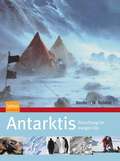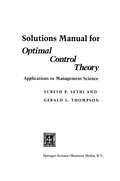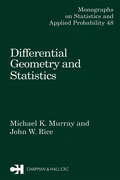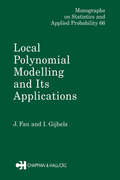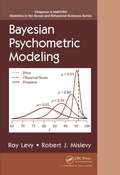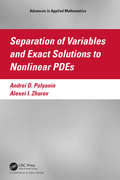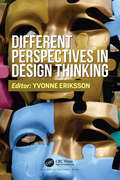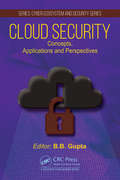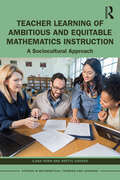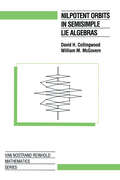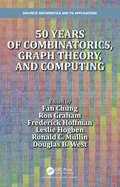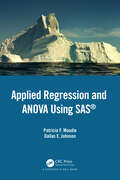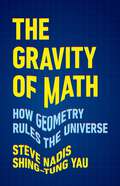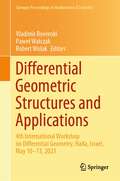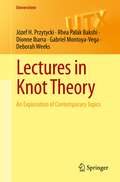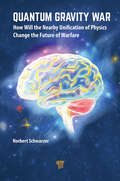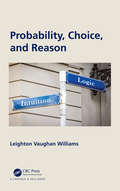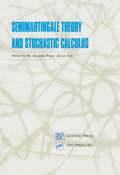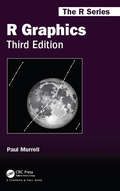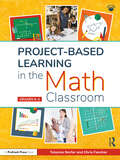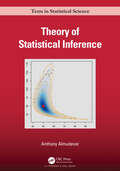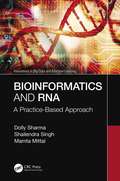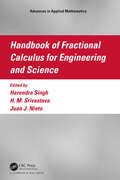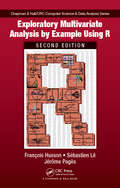- Table View
- List View
Solutions Manual for Optimal Control Theory: Applications to Management Science
by Suresh P. Sethi Gerald L. ThompsonDifferential Geometry and Statistics (ISSN)
by M.K. MurraySeveral years ago our statistical friends and relations introduced us to the work of Amari and Barndorff-Nielsen on applications of differential geometry to statistics. This book has arisen because we believe that there is a deep relationship between statistics and differential geometry and moreoever that this relationship uses parts of differential geometry, particularly its 'higher-order' aspects not readily accessible to a statistical audience from the existing literature. It is, in part, a long reply to the frequent requests we have had for references on differential geometry! While we have not gone beyond the path-breaking work of Amari and Barndorff- Nielsen in the realm of applications, our book gives some new explanations of their ideas from a first principles point of view as far as geometry is concerned. In particular it seeks to explain why geometry should enter into parametric statistics, and how the theory of asymptotic expansions involves a form of higher-order differential geometry. The first chapter of the book explores exponential families as flat geometries. Indeed the whole notion of using log-likelihoods amounts to exploiting a particular form of flat space known as an affine geometry, in which straight lines and planes make sense, but lengths and angles are absent. We use these geometric ideas to introduce the notion of the second fundamental form of a family whose vanishing characterises precisely the exponential families.
Local Polynomial Modelling and Its Applications: Monographs on Statistics and Applied Probability 66 (ISSN)
by Jianqing FanData-analytic approaches to regression problems, arising from many scientific disciplines are described in this book. The aim of these nonparametric methods is to relax assumptions on the form of a regression function and to let data search for a suitable function that describes the data well. The use of these nonparametric functions with parametric techniques can yield very powerful data analysis tools. Local polynomial modeling and its applications provides an up-to-date picture on state-of-the-art nonparametric regression techniques. The emphasis of the book is on methodologies rather than on theory, with a particular focus on applications of nonparametric techniques to various statistical problems. High-dimensional data-analytic tools are presented, and the book includes a variety of examples. This will be a valuable reference for research and applied statisticians, and will serve as a textbook for graduate students and others interested in nonparametric regression.
Bayesian Psychometric Modeling (Chapman & Hall/CRC Statistics in the Social and Behavioral Sciences)
by Roy Levy Robert J. MislevyA Single Cohesive Framework of Tools and Procedures for Psychometrics and AssessmentBayesian Psychometric Modeling presents a unified Bayesian approach across traditionally separate families of psychometric models. It shows that Bayesian techniques, as alternatives to conventional approaches, offer distinct and profound advantages in achieving many goals of psychometrics.Adopting a Bayesian approach can aid in unifying seemingly disparate—and sometimes conflicting—ideas and activities in psychometrics. This book explains both how to perform psychometrics using Bayesian methods and why many of the activities in psychometrics align with Bayesian thinking.The first part of the book introduces foundational principles and statistical models, including conceptual issues, normal distribution models, Markov chain Monte Carlo estimation, and regression. Focusing more directly on psychometrics, the second part covers popular psychometric models, including classical test theory, factor analysis, item response theory, latent class analysis, and Bayesian networks. Throughout the book, procedures are illustrated using examples primarily from educational assessments. A supplementary website provides the datasets, WinBUGS code, R code, and Netica files used in the examples.
Separation of Variables and Exact Solutions to Nonlinear PDEs (ISSN)
by Andrei D. Polyanin Alexei I. ZhurovSeparation of Variables and Exact Solutions to Nonlinear PDEs is devoted to describing and applying methods of generalized and functional separation of variables used to find exact solutions of nonlinear partial differential equations (PDEs). It also presents the direct method of symmetry reductions and its more general version. In addition, the authors describe the differential constraint method, which generalizes many other exact methods.The presentation involves numerous examples of utilizing the methods to find exact solutions to specific nonlinear equations of mathematical physics. The equations of heat and mass transfer, wave theory, hydrodynamics, nonlinear optics, combustion theory, chemical technology, biology, and other disciplines are studied.Particular attention is paid to nonlinear equations of a reasonably general form that depend on one or several arbitrary functions. Such equations are the most difficult to analyze. Their exact solutions are of significant practical interest, as they are suitable to assess the accuracy of various approximate analytical and numerical methods.The book contains new material previously unpublished in monographs. It is intended for a broad audience of scientists, engineers, instructors, and students specializing in applied and computational mathematics, theoretical physics, mechanics, control theory, chemical engineering science, and other disciplines. Individual sections of the book and examples are suitable for lecture courses on partial differential equations, equations of mathematical physics, and methods of mathematical physics, for delivering special courses and for practical training.
Different Perspectives in Design Thinking
by Yvonne ErikssonGlobalization and digitalization are buzz words in contemporary society. They affect both our private and our professional lives. Society has become more diverse with easier access to information and to virtual platforms that gives us opportunity to be in touch with colleagues, friends, family, etc. at any time. A complex environment is emerging wherein internet of things and big data are being integrated with products, production systems, healthcare, and daily activity and play an important part in decision making. This has an impact on future designs and the role of designers. Responsible designers with a holistic perspective are needed.The book highlights several aspects of design thinking such as Information Design and Critical Design. The meaning of culture, gender and disabilities are also discussed. The functions of Information Design are changing from ‘showing the way’, instruction manuals and graphic design. It will affect among others, healthcare technology, smart products and Industry 4.0. Design thinking perspective that includes users from the entire chain and from the producer to the end user of the product or service, is needed. This will also require gender and culture issues to be taken into consideration in designing products and services. Design thinking methods and critical aspects of design will contribute to an inclusive society.
Cloud Security: Concepts, Applications and Perspectives (Cyber Ecosystem and Security)
by Brij B GuptaCloud computing is an indispensable part of the modern Information and Communication Technology (ICT) systems. Cloud computing services have proven to be of significant importance, and promote quickly deployable and scalable IT solutions with reduced infrastructure costs. However, utilization of cloud also raises concerns such as security, privacy, latency, and governance, that keep it from turning into the predominant option for critical frameworks. As such, there is an urgent need to identify these concerns and to address them.Cloud Security: Concepts, Applications and Perspectives is a comprehensive work with substantial technical details for introducing the state-of-the-art research and development on various approaches for security and privacy of cloud services; novel attacks on cloud services; cloud forensics; novel defenses for cloud service attacks; and cloud security analysis. It discusses the present techniques and methodologies, and provides a wide range of examples and illustrations to effectively show the concepts, applications, and perspectives of security in cloud computing. This highly informative book will prepare readers to exercise better protection by understanding the motivation of attackers and to deal with them to mitigate the situation. In addition, it covers future research directions in the domain. This book is suitable for professionals in the field, researchers, students who are want to carry out research in the field of computer and cloud security, faculty members across universities, and software developers engaged in software development in the field.
Teacher Learning of Ambitious and Equitable Mathematics Instruction: A Sociocultural Approach (Studies in Mathematical Thinking and Learning Series)
by Ilana Horn Brette GarnerDrawing on sociocultural learning theory, this book offers a groundbreaking theory of secondary mathematics teacher learning in schools, focusing on the transformation of instruction as a conceptual change project to achieve ambitious and equitable mathematics teaching.Despite decades of research showing the importance of ambitious and equitable teaching, few inroads have been made in most U.S. classrooms, and teacher learning in general remains undertheorized in most educational research. Illustrating their theory through closely documented case studies of secondary mathematics teachers’ learning and instructional practices, authors Horn and Garner explore the key conceptual issues teachers are required to work through in order to more fully realize ambitious and equitable teaching in their classrooms. By theorizing teacher learning from a sociocultural perspective and focusing on instructional practice, the authors make a unique contribution to the field of teacher learning.This book offers researchers, scholars, and teacher educators new theoretical and methodological tools for the elusive phenomenon of teacher learning, and provides instructional leaders and coaches with practical examples of how teachers shift their thinking and practice.
Nilpotent Orbits In Semisimple Lie Algebra: An Introduction
by William.M. McGovernThrough the 1990s, a circle of ideas emerged relating three very different kinds of objects associated to a complex semisimple Lie algebra: nilpotent orbits, representations of a Weyl group, and primitive ideals in an enveloping algebra. The principal aim of this book is to collect together the important results concerning the classification and properties of nilpotent orbits, beginning from the common ground of basic structure theory. The techniques used are elementary and in the toolkit of any graduate student interested in the harmonic analysis of representation theory of Lie groups. The book develops the Dynkin-Konstant and Bala-Carter classifications of complex nilpotent orbits, derives the Lusztig-Spaltenstein theory of induction of nilpotent orbits, discusses basic topological questions, and classifies real nilpotent orbits. The classical algebras are emphasized throughout; here the theory can be simplified by using the combinatorics of partitions and tableaux. The authors conclude with a survey of advanced topics related to the above circle of ideas. This book is the product of a two-quarter course taught at the University of Washington.
50 years of Combinatorics, Graph Theory, and Computing (Discrete Mathematics and Its Applications)
by Fan Chung, Ron Graham, Frederick Hoffman, Leslie Hogben, Ronald C. Mullin and Douglas B. West50 Years of Combinatorics, Graph Theory, and Computing advances research in discrete mathematics by providing current research surveys, each written by experts in their subjects. The book also celebrates outstanding mathematics from 50 years at the Southeastern International Conference on Combinatorics, Graph Theory & Computing (SEICCGTC). The conference is noted for the dissemination and stimulation of research, while fostering collaborations among mathematical scientists at all stages of their careers. The authors of the chapters highlight open questions. The sections of the book include: Combinatorics; Graph Theory; Combinatorial Matrix Theory; Designs, Geometry, Packing and Covering. Readers will discover the breadth and depth of the presentations at the SEICCGTC, as well as current research in combinatorics, graph theory and computer science.Features: Commemorates 50 years of the Southeastern International Conference on Combinatorics, Graph Theory & Computing with research surveys Surveys highlight open questions to inspire further research Chapters are written by experts in their fields Extensive bibliographies are provided at the end of each chapter
Applied Regression and ANOVA Using SAS
by Patricia F. Moodie Dallas E. JohnsonApplied Regression and ANOVA Using SAS® has been written specifically for non-statisticians and applied statisticians who are primarily interested in what their data are revealing. Interpretation of results are key throughout this intermediate-level applied statistics book. The authors introduce each method by discussing its characteristic features, reasons for its use, and its underlying assumptions. They then guide readers in applying each method by suggesting a step-by-step approach while providing annotated SAS programs to implement these steps.Those unfamiliar with SAS software will find this book helpful as SAS programming basics are covered in the first chapter. Subsequent chapters give programming details on a need-to-know basis. Experienced as well as entry-level SAS users will find the book useful in applying linear regression and ANOVA methods, as explanations of SAS statements and options chosen for specific methods are provided.Features:•Statistical concepts presented in words without matrix algebra and calculus•Numerous SAS programs, including examples which require minimum programming effort to produce high resolution publication-ready graphics•Practical advice on interpreting results in light of relatively recent views on threshold p-values, multiple testing, simultaneous confidence intervals, confounding adjustment, bootstrapping, and predictor variable selection•Suggestions of alternative approaches when a method’s ideal inference conditions are unreasonable for one’s dataThis book is invaluable for non-statisticians and applied statisticians who analyze and interpret real-world data. It could be used in a graduate level course for non-statistical disciplines as well as in an applied undergraduate course in statistics or biostatistics.
The Gravity of Math: How Geometry Rules the Universe
by Steve Nadis Shing-Tung YauOne of the preeminent mathematicians of the past half century shows how physics and math were combined to give us the theory of gravity and the dizzying array of ideas and insights that has come from it Mathematics is far more than just the language of science. It is a critical underpinning of nature. The famed physicist Albert Einstein demonstrated this in 1915 when he showed that gravity—long considered an attractive force between massive objects—was actually a manifestation of the curvature, or geometry, of space and time. But in making this towering intellectual leap, Einstein needed the help of several mathematicians, including Marcel Grossmann, who introduced him to the geometrical framework upon which his theory rest. In The Gravity of Math, Steve Nadis and Shing-Tung Yau consider how math can drive and sometimes even anticipate discoveries in physics. Examining phenomena like black holes, gravitational waves, and the Big Bang, Nadis and Yau ask: Why do mathematical statements, derived solely from logic, provide the best descriptions of our physical world? The Gravity of Math offers an insightful and compelling look into the power of mathematics—whose reach, like that of gravity, can extend to the edge of the universe.
Differential Geometric Structures and Applications: 4th International Workshop on Differential Geometry, Haifa, Israel, May 10–13, 2023 (Springer Proceedings in Mathematics & Statistics #440)
by Vladimir Rovenski Paweł Walczak Robert WolakThis proceedings contains a collection of selected, peer-reviewed contributions from the 4th International Workshop "Differential Geometric Structures and Applications" held in Haifa, Israel from May 10–13, 2023. The papers included in this volume showcase the latest advancements in modern geometry and interdisciplinary applications in fields ranging from mathematical physics to biology.Since 2008, this workshop series has provided a platform for researchers in pure and applied mathematics, including students, to engage in discussions and explore the frontiers of modern geometry. Previous workshops in the series have focused on topics such as "Reconstruction of Geometrical Objects Using Symbolic Computations" (2008), "Geometry and Symbolic Computations" (2013), and "Geometric Structures and Interdisciplinary Applications" (2018).
Lectures in Knot Theory: An Exploration of Contemporary Topics (Universitext)
by Józef H. Przytycki Rhea Palak Bakshi Dionne Ibarra Gabriel Montoya-Vega Deborah WeeksThis text is based on lectures delivered by the first author on various, often nonstandard, parts of knot theory and related subjects. By exploring contemporary topics in knot theory including those that have become mainstream, such as skein modules, Khovanov homology and Gram determinants motivated by knots, this book offers an innovative extension to the existing literature. Each lecture begins with a historical overview of a topic and gives motivation for the development of that subject. Understanding of most of the material in the book requires only a basic knowledge of topology and abstract algebra. The intended audience is beginning and advanced graduate students, advanced undergraduate students, and researchers interested in knot theory and its relations with other disciplines within mathematics, physics, biology, and chemistry.Inclusion of many exercises, open problems, and conjectures enables the reader to enhance their understanding of the subject. The use of this text for the classroom is versatile and depends on the course level and choices made by the instructor. Suggestions for variations in course coverage are included in the Preface. The lecture style and array of topical coverage are hoped to inspire independent research and applications of the methods described in the book to other disciplines of science. An introduction to the topology of 3-dimensional manifolds is included in Appendices A and B. Lastly, Appendix C includes a Table of Knots.
Quantum Gravity War: How Will the Nearby Unification of Physics Change the Future of Warfare
by Norbert SchwarzerImagine a civilization with a technology so powerful that a single push of the “wrong” button could destroy this very entire civilization. As the consideration of future warfare requires the inclusion of a unified physics, we have to deal with complex concepts of Quantum Theory and General Theory of Relativity. The two have to be brought together before we are able to deal with the matter of future warfare technology in a satisfactory manner. That such a “Theory of Everything” or “Theory of Quantum Gravity”—in principle—already exists and had been already derived by the great German mathematician David Hilbert. When digging deeper and looking for applications of the “new” theory, we realized that many of the new possibilities could also lead to quite disastrous utilizations in military. It is futile to hope that mankind would not recognize this potential and restrain itself from its exploitation.Thus, we thought we better make this knowledge public and hope for some kind of global understanding, perhaps guaranteeing the non-usage of certain technologies. It might only be a weak hope, but in observing history and realizing how little we gained by keeping crucial knowledge restricted to some, thereby often only even more provoking the development of the most horrific weapons one could imagine at the time, we simply see no better way. This book does not provide blueprints ready to start the developments of new quantum gravity weaponry and strategies, but it draws the line that would suffice to awake the right forces and trigger the best developments … before the bad guys get the gist.
Quantum Gravity War: How Will the Nearby Unification of Physics Change the Future of Warfare
by Norbert SchwarzerImagine a civilization with a technology so powerful that a single push of the “wrong” button could destroy this very entire civilization. As the consideration of future warfare requires the inclusion of a unified physics, we have to deal with complex concepts of Quantum Theory and General Theory of Relativity. The two have to be brought together before we are able to deal with the matter of future warfare technology in a satisfactory manner. That such a “Theory of Everything” or “Theory of Quantum Gravity”—in principle—already exists and had been already derived by the great German mathematician David Hilbert. When digging deeper and looking for applications of the “new” theory, we realized that many of the new possibilities could also lead to quite disastrous utilizations in military. It is futile to hope that mankind would not recognize this potential and restrain itself from its exploitation.Thus, we thought we better make this knowledge public and hope for some kind of global understanding, perhaps guaranteeing the non-usage of certain technologies. It might only be a weak hope, but in observing history and realizing how little we gained by keeping crucial knowledge restricted to some, thereby often only even more provoking the development of the most horrific weapons one could imagine at the time, we simply see no better way. This book does not provide blueprints ready to start the developments of new quantum gravity weaponry and strategies, but it draws the line that would suffice to awake the right forces and trigger the best developments … before the bad guys get the gist.
Probability, Choice, and Reason
by Leighton Vaughan WilliamsMuch of our thinking is flawed because it is based on faulty intuition. By using the framework and tools of probability and statistics, we can overcome this to provide solutions to many real-world problems and paradoxes. We show how to do this, and find answers that are frequently very contrary to what we might expect. Along the way, we venture into diverse realms and thought experiments which challenge the way that we see the world.Features: An insightful and engaging discussion of some of the key ideas of probabilistic and statistical thinking Many classic and novel problems, paradoxes, and puzzles An exploration of some of the big questions involving the use of choice and reason in an uncertain world The application of probability, statistics, and Bayesian methods to a wide range of subjects, including economics, finance, law, and medicine Exercises, references, and links for those wishing to cross-reference or to probe further Solutions to exercises at the end of the book This book should serve as an invaluable and fascinating resource for university, college, and high school students who wish to extend their reading, as well as for teachers and lecturers who want to liven up their courses while retaining academic rigour. It will also appeal to anyone who wishes to develop skills with numbers or has an interest in the many statistical and other paradoxes that permeate our lives. Indeed, anyone studying the sciences, social sciences, or humanities on a formal or informal basis will enjoy and benefit from this book.
Semimartingale Theory and Stochastic Calculus
by Sheng-Wu He Jia-Gang Wang Jia-an YanSemimartingale Theory and Stochastic Calculus presents a systematic and detailed account of the general theory of stochastic processes, the semimartingale theory, and related stochastic calculus. The book emphasizes stochastic integration for semimartingales, characteristics of semimartingales, predictable representation properties and weak convergence of semimartingales. It also includes a concise treatment of absolute continuity and singularity, contiguity, and entire separation of measures by semimartingale approach. Two basic types of processes frequently encountered in applied probability and statistics are highlighted: processes with independent increments and marked point processes encountered frequently in applied probability and statistics. Semimartingale Theory and Stochastic Calculus is a self-contained and comprehensive book that will be valuable for research mathematicians, statisticians, engineers, and students.
R Graphics, Third Edition (Chapman & Hall/CRC The R Series)
by Paul MurrellThis third edition of Paul Murrell’s classic book on using R for graphics represents a major update, with a complete overhaul in focus and scope. It focuses primarily on the two core graphics packages in R - graphics and grid - and has a new section on integrating graphics. This section includes three new chapters: importing external images in to R; integrating the graphics and grid systems; and advanced SVG graphics.The emphasis in this third edition is on having the ability to produce detailed and customised graphics in a wide variety of formats, on being able to share and reuse those graphics, and on being able to integrate graphics from multiple systems.This book is aimed at all levels of R users. For people who are new to R, this book provides an overview of the graphics facilities, which is useful for understanding what to expect from R's graphics functions and how to modify or add to the output they produce. For intermediate-level R users, this book provides all of the information necessary to perform sophisticated customizations of plots produced in R. For advanced R users, this book contains vital information for producing coherent, reusable, and extensible graphics functions.
Project-Based Learning in the Math Classroom: Grades K-2
by Telannia Norfar Chris FancherProject-Based Learning in the Math Classroom: Grades K–2 explains how to keep inquiry at the heart of mathematics teaching in the elementary grades. Helping teachers integrate other subjects into the math classroom, this book outlines in-depth tasks, projects and routines to support Project-Based Learning (PBL). Featuring helpful tips for creating PBL units, alongside models and strategies that can be implemented immediately, Project-Based Learning in the Math Classroom: Grades K–2 understands that teaching in a project-based environment means using great teaching practices. The authors impart strategies that assist teachers in planning standards-based lessons, encouraging wonder and curiosity, providing a safe environment where mistakes can occur, and giving students opportunities for revision and reflection.
Theory of Statistical Inference (Chapman & Hall/CRC Texts in Statistical Science)
by Anthony AlmudevarTheory of Statistical Inference is designed as a reference on statistical inference for researchers and students at the graduate or advanced undergraduate level. It presents a unified treatment of the foundational ideas of modern statistical inference, and would be suitable for a core course in a graduate program in statistics or biostatistics. The emphasis is on the application of mathematical theory to the problem of inference, leading to an optimization theory allowing the choice of those statistical methods yielding the most efficient use of data. The book shows how a small number of key concepts, such as sufficiency, invariance, stochastic ordering, decision theory and vector space algebra play a recurring and unifying role. The volume can be divided into four sections. Part I provides a review of the required distribution theory. Part II introduces the problem of statistical inference. This includes the definitions of the exponential family, invariant and Bayesian models. Basic concepts of estimation, confidence intervals and hypothesis testing are introduced here. Part III constitutes the core of the volume, presenting a formal theory of statistical inference. Beginning with decision theory, this section then covers uniformly minimum variance unbiased (UMVU) estimation, minimum risk equivariant (MRE) estimation and the Neyman-Pearson test. Finally, Part IV introduces large sample theory. This section begins with stochastic limit theorems, the δ-method, the Bahadur representation theorem for sample quantiles, large sample U-estimation, the Cramér-Rao lower bound and asymptotic efficiency. A separate chapter is then devoted to estimating equation methods. The volume ends with a detailed development of large sample hypothesis testing, based on the likelihood ratio test (LRT), Rao score test and the Wald test. Features This volume includes treatment of linear and nonlinear regression models, ANOVA models, generalized linear models (GLM) and generalized estimating equations (GEE). An introduction to decision theory (including risk, admissibility, classification, Bayes and minimax decision rules) is presented. The importance of this sometimes overlooked topic to statistical methodology is emphasized. The volume emphasizes throughout the important role that can be played by group theory and invariance in statistical inference. Nonparametric (rank-based) methods are derived by the same principles used for parametric models and are therefore presented as solutions to well-defined mathematical problems, rather than as robust heuristic alternatives to parametric methods. Each chapter ends with a set of theoretical and applied exercises integrated with the main text. Problems involving R programming are included. Appendices summarize the necessary background in analysis, matrix algebra and group theory.
Bioinformatics and RNA: A Practice-Based Approach (Innovations in Big Data and Machine Learning)
by Dolly Sharma Shailendra Singh Mamta MittalThis book offers a unique balance between a basic introductory knowledge of bioinformatics and a detailed study of algorithmic techniques. Bioinformatics and RNA: A Practice-Based Approach is a complete guide on the fundamental concepts, applications, algorithms, protocols, new trends, challenges, and research results in the area of bioinformatics and RNA.The book offers a broad introduction to the explosively growing new discipline of bioinformatics. It covers theoretical topics along with computational algorithms. It explores RNA bioinformatics, which contribute to therapeutics and drug discovery. Implementation of algorithms in a DotNet Framework with code and complete insight on the state-of-the-art and recent advancements are presented in detail. The book targets both novice readers as well as practitioners in the field. FEATURES Offers a broad introduction to the explosively growing new discipline of bioinformatics Covers theoretical topics and computational algorithms Explores RNA bioinformatics to unleash the potential from therapeutics to drug discovery Discusses implementation of algorithms in DotNet Frameworks with code Presents insights into the state of the art and recent advancements in bioinformatics The book is useful to undergraduate students with engineering, science, mathematics, or biology backgrounds. Researchers will be equally interested.
Handbook of Fractional Calculus for Engineering and Science (ISSN)
by Harendra Singh H. M. Srivastava Juan J. NietoFractional calculus is used to model many real-life situations from science and engineering. The book includes different topics associated with such equations and their relevance and significance in various scientific areas of study and research. In this book readers will find several important and useful methods and techniques for solving various types of fractional-order models in science and engineering. The book should be useful for graduate students, PhD students, researchers and educators interested in mathematical modelling, physical sciences, engineering sciences, applied mathematical sciences, applied sciences, and so on. This Handbook: Provides reliable methods for solving fractional-order models in science and engineering. Contains efficient numerical methods and algorithms for engineering-related equations. Contains comparison of various methods for accuracy and validity. Demonstrates the applicability of fractional calculus in science and engineering. Examines qualitative as well as quantitative properties of solutions of various types of science- and engineering-related equations. Readers will find this book to be useful and valuable in increasing and updating their knowledge in this field and will be it will be helpful for engineers, mathematicians, scientist and researchers working on various real-life problems.
Exploratory Multivariate Analysis by Example Using R (Chapman & Hall/CRC Computer Science & Data Analysis)
by Francois Husson Sebastien Le Jérôme PagèsFull of real-world case studies and practical advice, Exploratory Multivariate Analysis by Example Using R, Second Edition focuses on four fundamental methods of multivariate exploratory data analysis that are most suitable for applications. It covers principal component analysis (PCA) when variables are quantitative, correspondence analysis (CA) a
